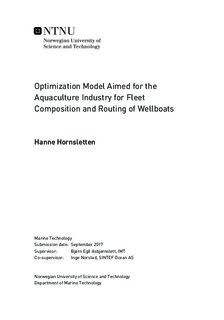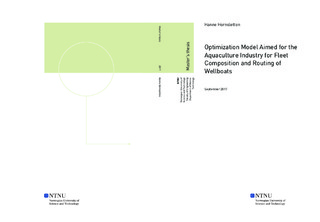| dc.description.abstract | The Norwegian aquaculture industry is continuously seeking further growth, and aims to almost fivefold today s salmon production within the year of 2050. As the aquaculture industry is experiencing remarkable growth and technological development, so does the fleet of wellboats in order to respond to the development and production growth. The wellboats play a central role in the salmon farming industry, and constitute a significant economical investment for the farming companies. It could therefore be of high value to look into a decision making support tool to make and evaluate decisions regarding fleet composition and routing of wellboats in relation to the future transportation demands and requirements. The aim for this study is therefor to look into the modeling of wellboat operations, in order to create an optimization model to provide as a basis for further development of such a tactical decision-making support tool. The problem for this study is to minimize the costs of operating a fleet of wellboats servicing the required demands in the aquaculture industry within a given area. The focus is therefor on the fleet of wellboats and the service tasks these vessels have to execute. The problem area is reduced to the area around Hitra and Frøya. It is for this area established the scope of locations and production volumes, along with the yearly demands for the different wellboat operations. Three vessel types are established according to size, all with the ability to service all operational tasks. The execution of these tasks is described, together with the assumed associated time-consuming factors.
A literature review is done in order to gain knowledge on similar problems. Literature and research on vehicle routing problems (VRP), pickup and delivery problems (PDP) and ship routing and scheduling problems are studied in order to obtain an idea of how to approach the problem at hand. The model is presented as an arc flow formulation of an industrial ship scheduling problem with full shiploads, with similarities to a VRP with pickup and delivery and time windows (VRPPDTW). This model aims to minimize the total cost of routing the vessels in the available fleet of wellboats, while servicing the required demand. The model is kept simple and generic by moving a lot of data pre-processing into Excel, with the attempt to make it more flexible.
The mathematical model is implemented in the commercial solver Xpress, running multiple demand scenarios to test the applicability of the model. The model is first tested with different seasonal demands in order to find a fleet composition to be suited for all seasons. Further, the model is run with future additional tasks related to alternating lice demands and the introduction of exposed aquaculture. These scenarios are run in order to establish eventual alterations to the fleet composition due to the change in demand. The first demand scenario resulted in an optimal fleet consisting of at least two wellboats of type 3, and an additional wellboat of type 2. Running the model with the different future demands shows a need to expand the fleet set to handle the seasonal demands. A wellboat of type 3 should either replace the wellboat of type 2, or be added additionally together with a wellboat of type 1, which can be a suitable asset to handle the smaller demands.
The results seem quite reasonable with respect to the fleet compositions chosen for the different scenarios. Most of the scenarios imply the need for new or larger vessels when applying increased service demands or stricter time windows. The routing decisions for each scenario tend to follow the expected sequences in accordance with the transition costs and the time windows set.
Disregarding some shortcomings, the created model for this study is concluded to be a good basis for further development, to possibly become a contributing decision-making support tool to be applied for fleet composition and routing in the aquaculture industry. The approach to simplify the optimization model and focus on making the Excel-file flexible, makes the model quite susceptible for changes. New tasks, vessel types, locations or geographical nodes can therefor easily be added with associated data, without causing any alterations to the optimization model itself. | |

